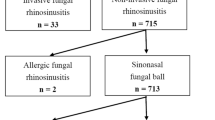Abstract
Purpose
Many physicians recommend endoscopic sinus surgery (ESS) even when an asymptomatic paranasal sinus (PNS) fungal ball is detected incidentally. The aim of this study was to investigate the natural behavior of PNS fungal balls via sinus imaging techniques.
Methods
A follow-up study of 74 pathologically confirmed fungus balls was conducted in 70 patients who underwent multiple head and neck computed tomography (CT) scans or magnetic resonance imaging (MRI). We investigated the changes in symptoms and lesion size, as well as any new occurrences.
Results
Of the 74 fungus balls detected in 70 patients, we observed the renewed formation of a fungal ball in 21 patients, which was not present on initial imaging conducted over a period of 2–162 months. The fungal ball was already present in 53 patients on the initial screening, and the longest follow-up was 197 months (range 1–197 months). Of these 53 lesions, 29 lesions showed an increase in size (29/53, 54.7%), whereas 12 lesions were not associated with any clinical symptoms (12/53, 22.6%). In the 21 newly formed fungal balls, further development was observed in 10 lesions, with 4 lesions showing an increase in size. Thus, size increment occurred in 33 of the 57 fungus balls.
Conclusions
The fungal balls can exist without local tissue invasion for up to 17 years and new formation of the fungal balls was observed even within 2 months, especially when accompanied by initial clinical symptoms of sinusitis.

Similar content being viewed by others
References
Thompson GR 3rd, Patterson TF (2012) Fungal disease of the nose and paranasal sinuses. J Allergy Clin Immunol 129:321–326
Grosjean P, Weber R (2007) Fungus balls of the paranasal sinuses: a review. Eur Arch Otorhinolaryngol 264:461–470
Dufour X, Kauffmann-Lacroix C, Ferrie JC, Goujon JM, Rodier MH, Karkas A, Klossek JM (2005) Paranasal sinus fungus ball and surgery: a review of 175 cases. Rhinology 43:34–39
Raz E, Win W, Hagiwara M, Lui YW, Cohen B, Fatterpekar GM (2015) Fungal sinusitis. Neuroimaging Clin N Am 25:569–576
Zinreich SJ, Kennedy DW, Malat J, Curtin HD, Epstein JI, Huff LC, Kumar AJ, Johns ME, Rosenbaum AE (1988) Fungal sinusitis: diagnosis with CT and MR imaging. Radiology 169:439–444
Dhong HJ, Jung JY, Park JH (2000) Diagnostic accuracy in sinus fungus balls: CT scan and operative findings. Am J Rhinol 14:227–231
Nicolai P, Lombardi D, Tomenzoli D, Villaret AB, Piccioni M, Mensi M, Maroldi R (2009) Fungus ball of the paranasal sinuses: experience in 160 patients treated with endoscopic surgery. Laryngoscope 119:2275–2279
Rosenfeld RM, Piccirillo JF, Chandrasekhar SS, Brook I, Ashok Kumar K, Kramper M, Orlandi RR, Palmer JN, Patel ZM, Peters A, Walsh SA, Corrigan MD (2015) Clinical practice guideline (update): adult sinusitis. Otolaryngol Head Neck Surg 152:S1–S39
Ponikau JU, Sherris DA, Kern EB, Homburger HA, Frigas E, Gaffey TA, Roberts GD (1999) The diagnosis and incidence of allergic fungal sinusitis. Mayo Clin Proc 74:877–884
Leroux E, Valade D, Guichard JP, Herman P (2009) Sphenoid fungus balls: clinical presentation and long-term follow-up in 24 patients. Cephalalgia 29:1218–1223
Bekker AY, Weeks EJ (2003) Cognitive function after anaesthesia in the elderly. Best Pract Res Clin Anaesthesiol 17:259–272
Pedersen T, Eliasen K, Henriksen E (1990) A prospective study of risk factors and cardiopulmonary complications associated with anaesthesia and surgery: risk indicators of cardiopulmonary morbidity. Acta Anaesthesiol Scand 34:144–155
Akimoto T, Saito O, Inoue M, Nishino K, Onishi A, Kotoda A, Ando Y, Muto S, Kusano E (2007) Rapid formation of Aspergillus mycetoma in a patient receiving corticosteroid treatment. Serial radiographic observation over two months. Intern Med 46:733–737
Author information
Authors and Affiliations
Corresponding author
Ethics declarations
Conflict of interest
All authors declare that they have no conflict of interest.
Research involving human participants and/or animals
This study protocol was reviewed and approved by the Institutional Ethics Committee at the Samsung Medical Center (IRB number: SMC 2017-11-049).
Rights and permissions
About this article
Cite this article
Seo, M.Y., Lee, S.H., Ryu, G. et al. Clinical pattern of fungal balls in the paranasal sinuses: our experience with 70 patients. Eur Arch Otorhinolaryngol 276, 1035–1038 (2019). https://doi.org/10.1007/s00405-018-5258-z
Received:
Accepted:
Published:
Issue Date:
DOI: https://doi.org/10.1007/s00405-018-5258-z




